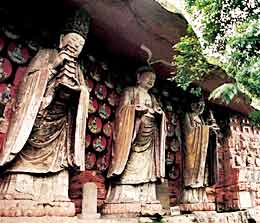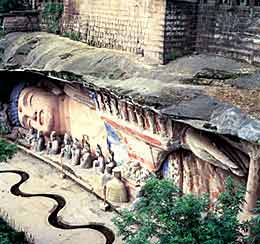Difference between revisions of "Dazu Rock Carvings"
imported>Graceshanshan |
imported>Graceshanshan |
||
| Line 1: | Line 1: | ||
'''Dazu Rock Carvings''' | '''Dazu Rock Carvings''' | ||
---- | ---- | ||
| − | In Dazu County, some 165 kilometers away from [[Chongqing]], are more than 40 sites of stone carvings with over 50,000 statues of Buddha completed from the late [[Tang Dynasty]] to the [[Song Dynasty]]. The grottoes on the Beishan Hill and Baoding Hill are the largest in scale, richest in content and most refined in artistic skill. | + | [[File:dazu1.jpg|thumb|right|Dazu Rock Carvings]][[File:Dazu2.jpg|thumb|right|Dazu Rock Carvings]][[File:Example.jpg]]In Dazu County, some 165 kilometers away from [[Chongqing]], are more than 40 sites of stone carvings with over 50,000 statues of Buddha completed from the late [[Tang Dynasty]] to the [[Song Dynasty]]. The grottoes on the Beishan Hill and Baoding Hill are the largest in scale, richest in content and most refined in artistic skill. |
Construction began on the Beishan Hill in the late Tang Dynasty and lasted for more than 250 years, with some 300 niches containing some 10,000 statues of Buddha being carved. The cave bearing the openwork octagonal "soul chariot" which symbolizes the eternal turning of the wheel of Buddhist law is the most fantastic piece of work. Right in the center of the cave is the statue of Sakyamuni, founder of Buddhism, which is flanked by more than 20 statues including the Buddha of wisdom and universal benevolence. | Construction began on the Beishan Hill in the late Tang Dynasty and lasted for more than 250 years, with some 300 niches containing some 10,000 statues of Buddha being carved. The cave bearing the openwork octagonal "soul chariot" which symbolizes the eternal turning of the wheel of Buddhist law is the most fantastic piece of work. Right in the center of the cave is the statue of Sakyamuni, founder of Buddhism, which is flanked by more than 20 statues including the Buddha of wisdom and universal benevolence. | ||
Revision as of 07:08, 2 June 2009
Dazu Rock Carvings
 In Dazu County, some 165 kilometers away from Chongqing, are more than 40 sites of stone carvings with over 50,000 statues of Buddha completed from the late Tang Dynasty to the Song Dynasty. The grottoes on the Beishan Hill and Baoding Hill are the largest in scale, richest in content and most refined in artistic skill.
In Dazu County, some 165 kilometers away from Chongqing, are more than 40 sites of stone carvings with over 50,000 statues of Buddha completed from the late Tang Dynasty to the Song Dynasty. The grottoes on the Beishan Hill and Baoding Hill are the largest in scale, richest in content and most refined in artistic skill.
Construction began on the Beishan Hill in the late Tang Dynasty and lasted for more than 250 years, with some 300 niches containing some 10,000 statues of Buddha being carved. The cave bearing the openwork octagonal "soul chariot" which symbolizes the eternal turning of the wheel of Buddhist law is the most fantastic piece of work. Right in the center of the cave is the statue of Sakyamuni, founder of Buddhism, which is flanked by more than 20 statues including the Buddha of wisdom and universal benevolence.
Samantabhadra, or Bodhisattva of Universal Benevolence, was meticulously designed and executed with refined lines to give her a womanly image with graceful features, soft skin, gentle and tranquil expression and elegant posture. Her typical image of an Eastern beauty has won her the description as the "Venus of the East".
The carvings on Baoding Hill, dating back over 800 years, are magnificent. In the vicinity of the Baoding Hill are over 10,000 Buddha statues, mostly found near Dafowan, which is a horseshoe shaped gully about 500 meters long. Here, on the cliffs between 15 and 30 meters high, rows upon rows of large-size carvings can be found either on the cliff face or inside the caves.
In 1999, the stone grottoes in Dazu entered the world cultural heritage list.

